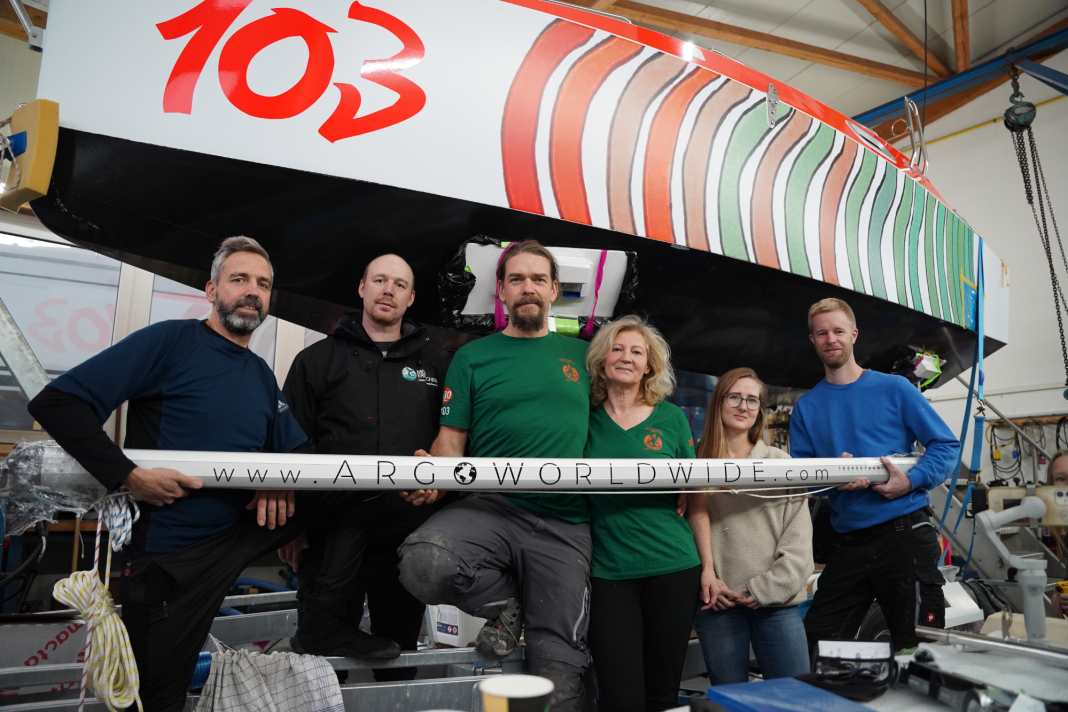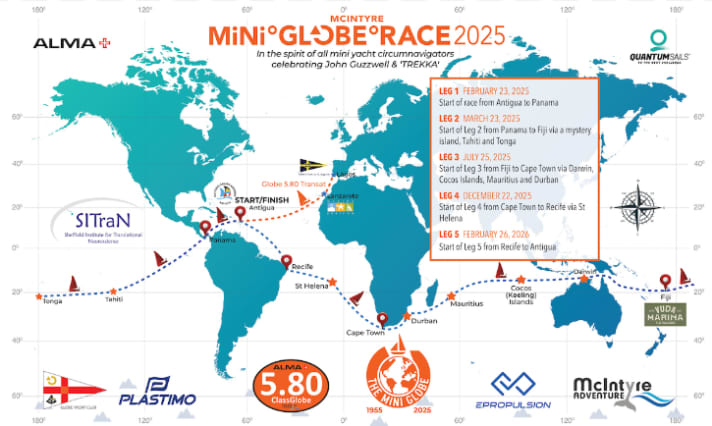





- "Simple boat with a great design"
- More favourable than an IMOCA foil
- Transparency through the "Builders Blog"
- Christian Sauer on the road to success
- The greatest opponent is time
- Globe 5.80: the smallest unit class, in the race around the world
- "An insane amount of trust in the boat"
The idea behind the Globe 5.80 class is simple. First you build your own boat - a 5.80 metre long small cruiser made of plywood and coated with fibreglass and epoxy. And in the next step, nothing stands in the way of an ocean crossing. This is where the 15 participants in this year's Globe 5.80 Transat race stand. On Saturday 28 December, they will set off from Lagos in Portugal for the Caribbean. It will be the third time after 2021 and 2023 that a fleet adventurous sailor on the way across the Atlantic - on their self-built boats.
"Simple boat with a great design"
The offshore small cruiser was designed by Janusz Maderski from Poland. He has already designed the Setka A-Class - a five-metre-long boat with which sailors have repeatedly ventured across the Atlantic. The Class Globe 5.80 is in turn a further development of this ocean-going mini.
The length of 5.80 metres is characteristic of the class. It was chosen so that the boat can be transported in a 20-foot container. Other special features include the bowsprit crack, the two watertight bulkheads and a skeg in front of the rudder. "It's a very simple boat, with a great design - nothing super technical. It takes you back to pure sailing", says the founder of the class, Australian Don McIntyre.
More favourable than an IMOCA foil
The Globe 5.80 should be fun to build and affordable at the same time. It's about enjoying the project and being part of an international community of self-builders and sailors, says McIntyre in an interview with YACHT (08/2020). He sees advantages for the Class Globe 5.80, particularly in terms of costs. "The entire fleet of 15 yachts has a lower value than a single foil of an IMOCA. Nevertheless, they are powerful and tested ocean travellers that have been specially developed to sail around the world on their own - just like an IMOCA," he says. McIntyre.
Transparency through the "Builders Blog"
This is certainly one of the reasons why more and more curious people are taking on the DIY project. This is also reflected in the increasing number of posts in the Builders Blog of Class Globe 5.80. The purpose of this website is for any self-builder who wishes to be registered by the International Class Association to officially document their build. The latest blog entry lists hull number 235, which means that more than 235 plans have already been sold. However, this number does not necessarily reflect the actual number of hulls in existence, as not every build is realised to the end. The number of boats actually in existence is therefore likely to be significantly lower.
Christian Sauer on the road to success
One person who has made it is Christian Sauer. He is one of eight Germans so far to have started the self-build project and one of the few to have completed it. He started building in July 2021. He has no boat-building experience, says Sauer. However, as a trained carpenter and qualified civil engineer, he is not too unfamiliar with the craft.
He did everything himself: solid wood frame, plywood hull and interior, laminating. He bought the plan online for 300 euros, the wood, CNC-milled, as a kit. He cast the lead keel bomb himself. "If you enjoy craftsmanship, it really gives you a lot - but it's also an incredible amount of work," says Sauer. In the beginning, he was still building it himself alongside his job. But he has been doing it full-time since December 2023.
The greatest opponent is time
One problem he had to contend with during the construction period was time. In particular, delivery problems with some components caused him problems. Many things were delayed: the electrician needed five weeks instead of two. He also had to make phone calls after many of the components. That's why the panic level was high, Sauer said a few days before the start. "When I realised that I wouldn't be at home for the next 15 months, it really set my pulse racing." Now, shortly before the start, the mood swings from one extreme to the other. And he doesn't know whether everything will work out in the end. "But I'm fighting for it," says Sauer.
More on the topic:
Christian Sauer has overcome a first hurdle. In mid-December, he towed his boat to Lagos on a trailer. The final preparations are now underway there. Setting the mast, rigging, fitting the engine and testing as much as possible before setting off. There are also safety briefings and health and equipment checks that all participants have to go through before the start.
Globe 5.80: the smallest unit class, in the race around the world
If everything goes according to plan, Christian Sauer and 11 others will start the first leg of the Globe 5.80 Transat race on Saturday, 28 December 2024. According to the organisers, this is more of a qualifying trip than a race. From Lagos in Portugal, the journey will cover around 550 nautical miles to Marina Rubicon on Lanzarote. From there, the second leg begins on 11 January - the actual Transat race and also the second qualification. The 3,000 nautical miles will take them across the Atlantic to the Caribbean island of Antigua.
Once there, Christian Sauer will have to decide whether to continue his journey. Antigua is not only the destination of the Transat race, but also the starting point for the Mini Globe Race.
More about the Mini Globe Race
The Mini Globe Race is the first of its kind: the first race around the world for the world's smallest standardised class.
- The two stages of the Globe 5.80 Transat - from Lagos to Lanzarote and to Antigua - are the two qualifying races for the Mini Globe Race. If the participants complete both stages, they can take part in the race around the world.
- The barefoot route then takes you around the world in a total of four further stages with numerous possible stopovers. The start in Antigua is the 23 February 2025.

- Estimated arrival at the finish in Antigua is March 2026 after 13 months of circumnavigation.
- More information about the Mini Globe Race here.
"An insane amount of trust in the boat"
Christian Sauer is optimistic ahead of the start in Lagos. He feels ready for the race, even though he has barely test sailed his "Argo":
"I have incredible confidence in the design and workmanship of the boat. That's why I feel absolutely confident."
After all, he has held every screw and every plank of the boat in his own hands. And one thing is already certain: the many hours of hard work will certainly stand him in good stead over the next 15 months at sea.

